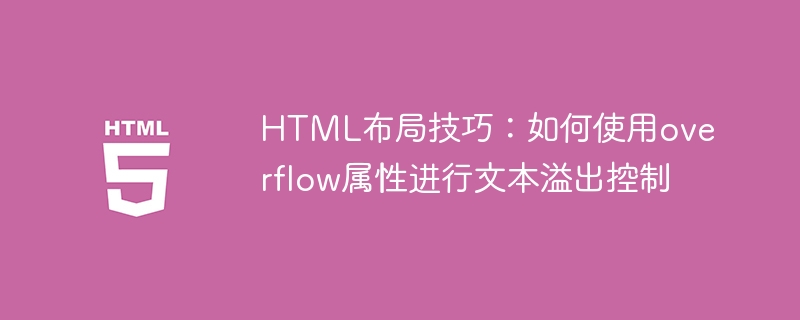Home >Web Front-end >HTML Tutorial >HTML layout tips: How to use the overflow attribute for text overflow control
HTML layout tips: How to use the overflow attribute for text overflow control
- WBOYWBOYWBOYWBOYWBOYWBOYWBOYWBOYWBOYWBOYWBOYWBOYWBOriginal
- 2023-10-19 11:30:501499browse

HTML layout skills: How to use the overflow attribute for text overflow control
In web development, sometimes we often encounter the problem of text content that is too long and overflows. In order to control this overflow and make the web page layout more beautiful and regular, you can use the overflow attribute of CSS. This article will introduce how to use the overflow attribute and provide specific code examples.
1. The role of the overflow attribute
The overflow attribute is used to control how the element content overflows. Overflow occurs when the content of an element exceeds its set width or height. The overflow attribute can control the expression of this overflow. It usually has the following values:
- visible: The content will not be trimmed and will overflow outside the element box. It's the default value.
- hidden: The content is trimmed and not visible.
- scroll: The content is trimmed, but scroll bars are provided to view the remaining content.
- auto: Automatically provide scroll bars if the content overflows.
When dealing with text content overflow, hidden and ellipsis are often used.
2. Use hidden to control text overflow
The hidden value means that when the element content overflows, it will be trimmed and hidden, making it invisible. By setting the overflow attribute to hidden, you can achieve the hiding effect of text overflow. The following is a sample code:
<!DOCTYPE html>
<html>
<head>
<style>
.container {
width: 200px;
height: 100px;
border: 1px solid black;
overflow: hidden;
text-overflow: ellipsis;
}
</style>
</head>
<body>
<div class="container">
Lorem ipsum dolor sit amet, consectetur adipiscing elit. Mauris ac nisi sed est hendrerit hendrerit nec at ipsum. Sed finibus diam urna, a convallis ex auctor non. Praesent ornare mi sed iaculis hendrerit. Sed vitae ipsum et nisi vestibulum tincidunt vel eu erat. Sed suscipit dui eu felis commodo aliquet.
</div>
</body>
</html>In the above code, a container element div is used, and a solid black line with a width of 200px, a height of 100px, and a border of 1px is set. By setting the overflow attribute to hidden, when the text content overflows, the excess part will be hidden and will not be displayed. This achieves the effect of text content overflow control.
3. Use ellipsis to display ellipsis when text overflows
In some cases, we hope to display ellipsis when text overflows to prompt the user that there is more content to view. At this time, you can use the text-overflow property of CSS and the ellipsis keyword to achieve this. The following is a sample code:
<!DOCTYPE html>
<html>
<head>
<style>
.container {
width: 200px;
height: 100px;
border: 1px solid black;
overflow: hidden;
text-overflow: ellipsis;
white-space: nowrap;
}
</style>
</head>
<body>
<div class="container">
Lorem ipsum dolor sit amet, consectetur adipiscing elit. Mauris ac nisi sed est hendrerit hendrerit nec at ipsum. Sed finibus diam urna, a convallis ex auctor non. Praesent ornare mi sed iaculis hendrerit. Sed vitae ipsum et nisi vestibulum tincidunt vel eu erat. Sed suscipit dui eu felis commodo aliquet.
</div>
</body>
</html>In the above code, by setting the text-overflow property to ellipsis, when the text content overflows, the excess part will be displayed as ellipses (...). At the same time, by setting the white-space attribute to nowrap, the text is displayed in one line so that the ellipsis can be displayed. This achieves the effect of displaying ellipsis when the text overflows.
In summary, using the overflow attribute to control the overflow of text content can effectively solve the overflow problem in web page layout. According to actual needs, different overflow control effects can be achieved by selecting the appropriate overflow value and combining it with other related attributes. I hope you find the specific code examples provided in this article helpful.
The above is the detailed content of HTML layout tips: How to use the overflow attribute for text overflow control. For more information, please follow other related articles on the PHP Chinese website!

